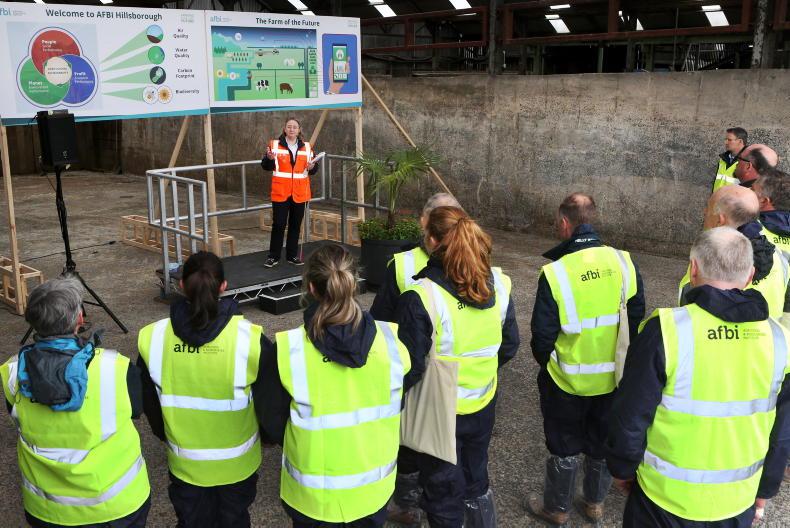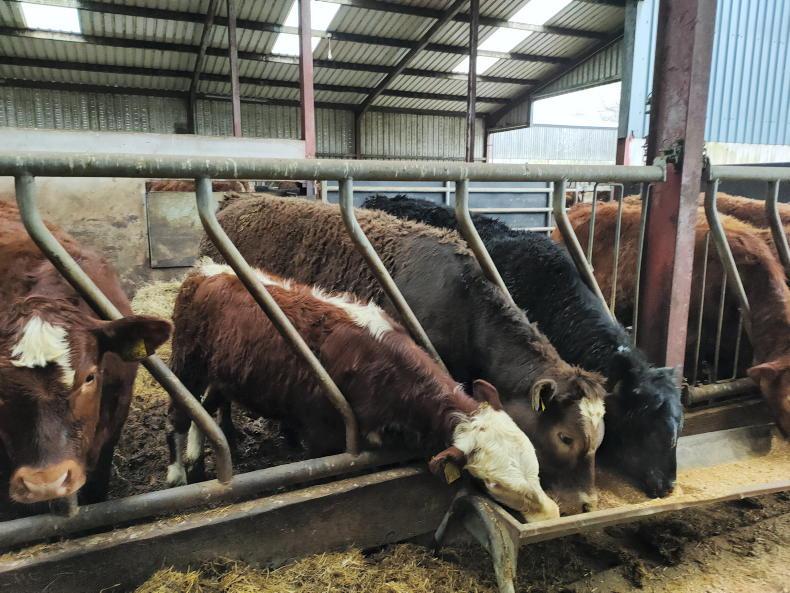Local farmers shouldn’t be scared of carbon benchmarking as the data will highlight areas of improvement that ultimately will make farms more efficient and profitable, Professor Elizabeth Magowan has suggested.
In an interview with the Irish Farmers Journal, the Agri-Food and Biosciences Institute (AFBI) Director acknowledged that big changes are coming for farmers on the back of local Climate Change legislation, and renewed pressure from major retailers for carbon audits on farms.
Ultimately, farmers will have to contribute towards the overall UK target of net zero greenhouse gas emissions by 2050. The first step in that is to make best use of inputs on farms, utilising knowledge we already have.
“There are gains to be made. All farming systems can be more efficient,” suggested Prof Magowan.
Those gains are highlighted in a recent report produced by a science consortium led by AFBI researchers on behalf of the Centre for Innovation and Excellence in Livestock (CIEL). That work showed that widespread adoption of key mitigations such as calving heifers at two years, improved grassland management and slaughtering cattle at younger ages could all help contribute towards a UK-wide 23% reduction in emissions.

Alex Higgins AFBI discussing the benefits of having trees on a farm during the ARCZero walk on the Harbison farm outside Aghadowey, Co. Derry \ Houston Green
But a significant proportion of this gain is also due to emerging technologies such as the inclusion of methane inhibitors in feed. With methane released in the animal digestion process the largest contributor to greenhouse gas (GHG) emissions on ruminant livestock farms, it is a key area of work over the next two to three years within AFBI.
“We are doing a lot of trials along with Queen’s University Belfast, including on various methane inhibitors, as well as willow leaves, seaweed, and multi-species swards (MSS). The initial science suggests that methane inhibitors will improve the efficiency of the digestion process and some may also improve performance,” said Prof Magowan.
She expects that these inhibitors will probably be most effective in a TMR, and there is therefore the challenge of getting them consumed by livestock in a grazing situation.
Ultimately, one of the main aims of the research will be to establish an emission factor, so when the technology is adopted by farmers, the resultant cut in methane output can be accurately predicted and adopted within the inventory.
Fertiliser
As well as methane inhibitors, the CIEL report also highlights that fertiliser often accounts for 15 to 20% of GHG emissions from farms, so greater use of clover will reduce emissions. On some farms, MSS could play an important role during periods of drought, while their long rooting systems should help sequestration of carbon into the soil.
“MSS have potential to be a big part of the future, but it is clover within the MSS that is the secret ingredient from an emissions point of view,” said Prof Magowan.
Carbon in soils
On the issue of carbon sequestration, she accepts that NI farmers are sitting on thousands of tonnes of carbon in their soils. As part of the new soil nutrient health scheme, these carbon stocks will be measured on each farm. But the most important analysis will be done five years later when these stocks are re-assessed, and it can be established what management practices in the period have contributed most carbon sequestration.
One thing we do know from long term slurry plots at AFBI is that soil carbon stocks can increase, even after 50 years of intensive cattle slurry application.
“Livestock farming will create the slurry that will contribute to a lot of that future sequestration, but this needs balanced with impacts on water and air quality ,” suggests Prof Magowan.
Among the other assumptions in the CIEL report is that all slurry from the likes of dairy and pigs is treated through an anaerobic digestion (AD) facility. Rather than methane being lost during storage and spreading, it is captured during the AD process, with the resultant biogas able to displace fossil fuels.
Carbon calculators and freed up land
If farmers make good use of the data that will come from the soil nutrient health scheme, and adopt the principle of annual carbon audits on their farms, Prof Magowan is convinced that it will lead to more sustainable farm businesses in NI.
But a more efficient business is potentially able to carry more livestock, so while GHG emissions per litre or kg might be lower, across the entire farm they will go up if stocking rates increase.
“Our vision is that by farming more efficiently we free up land for trees or energy crops. That land will still be able to generate income in its own right. It is about having the right tree in the right place, on the right land – that is not necessarily on your best land,” responded Prof Magowan.
Gaps
She is aware there are many gaps in our knowledge still to be filled, and that under the current accounting system for emissions, it is virtually impossible for a NI livestock farm to reach net zero. Instead, she maintains the focus must be on having “a low carbon agricultural industry”.
Crucial to that is the annual carbon audit, but with a myriad of carbon calculators on the market from different commercial companies, it does not help to create a consistent message.
“For the good of everyone, we need one calculator, although I suspect there is no easy route through that at the minute,” responded Prof Magowan. “But the bottom line is you chose a calculator, you use it to get data, and you act on that data. It is a tool to help farmers understand their carbon footprint,” she added.
Read more
Fifty years of Hillsborough slurry plots
Scientists identify key factors in cutting emissions
Local farmers shouldn’t be scared of carbon benchmarking as the data will highlight areas of improvement that ultimately will make farms more efficient and profitable, Professor Elizabeth Magowan has suggested.
In an interview with the Irish Farmers Journal, the Agri-Food and Biosciences Institute (AFBI) Director acknowledged that big changes are coming for farmers on the back of local Climate Change legislation, and renewed pressure from major retailers for carbon audits on farms.
Ultimately, farmers will have to contribute towards the overall UK target of net zero greenhouse gas emissions by 2050. The first step in that is to make best use of inputs on farms, utilising knowledge we already have.
“There are gains to be made. All farming systems can be more efficient,” suggested Prof Magowan.
Those gains are highlighted in a recent report produced by a science consortium led by AFBI researchers on behalf of the Centre for Innovation and Excellence in Livestock (CIEL). That work showed that widespread adoption of key mitigations such as calving heifers at two years, improved grassland management and slaughtering cattle at younger ages could all help contribute towards a UK-wide 23% reduction in emissions.

Alex Higgins AFBI discussing the benefits of having trees on a farm during the ARCZero walk on the Harbison farm outside Aghadowey, Co. Derry \ Houston Green
But a significant proportion of this gain is also due to emerging technologies such as the inclusion of methane inhibitors in feed. With methane released in the animal digestion process the largest contributor to greenhouse gas (GHG) emissions on ruminant livestock farms, it is a key area of work over the next two to three years within AFBI.
“We are doing a lot of trials along with Queen’s University Belfast, including on various methane inhibitors, as well as willow leaves, seaweed, and multi-species swards (MSS). The initial science suggests that methane inhibitors will improve the efficiency of the digestion process and some may also improve performance,” said Prof Magowan.
She expects that these inhibitors will probably be most effective in a TMR, and there is therefore the challenge of getting them consumed by livestock in a grazing situation.
Ultimately, one of the main aims of the research will be to establish an emission factor, so when the technology is adopted by farmers, the resultant cut in methane output can be accurately predicted and adopted within the inventory.
Fertiliser
As well as methane inhibitors, the CIEL report also highlights that fertiliser often accounts for 15 to 20% of GHG emissions from farms, so greater use of clover will reduce emissions. On some farms, MSS could play an important role during periods of drought, while their long rooting systems should help sequestration of carbon into the soil.
“MSS have potential to be a big part of the future, but it is clover within the MSS that is the secret ingredient from an emissions point of view,” said Prof Magowan.
Carbon in soils
On the issue of carbon sequestration, she accepts that NI farmers are sitting on thousands of tonnes of carbon in their soils. As part of the new soil nutrient health scheme, these carbon stocks will be measured on each farm. But the most important analysis will be done five years later when these stocks are re-assessed, and it can be established what management practices in the period have contributed most carbon sequestration.
One thing we do know from long term slurry plots at AFBI is that soil carbon stocks can increase, even after 50 years of intensive cattle slurry application.
“Livestock farming will create the slurry that will contribute to a lot of that future sequestration, but this needs balanced with impacts on water and air quality ,” suggests Prof Magowan.
Among the other assumptions in the CIEL report is that all slurry from the likes of dairy and pigs is treated through an anaerobic digestion (AD) facility. Rather than methane being lost during storage and spreading, it is captured during the AD process, with the resultant biogas able to displace fossil fuels.
Carbon calculators and freed up land
If farmers make good use of the data that will come from the soil nutrient health scheme, and adopt the principle of annual carbon audits on their farms, Prof Magowan is convinced that it will lead to more sustainable farm businesses in NI.
But a more efficient business is potentially able to carry more livestock, so while GHG emissions per litre or kg might be lower, across the entire farm they will go up if stocking rates increase.
“Our vision is that by farming more efficiently we free up land for trees or energy crops. That land will still be able to generate income in its own right. It is about having the right tree in the right place, on the right land – that is not necessarily on your best land,” responded Prof Magowan.
Gaps
She is aware there are many gaps in our knowledge still to be filled, and that under the current accounting system for emissions, it is virtually impossible for a NI livestock farm to reach net zero. Instead, she maintains the focus must be on having “a low carbon agricultural industry”.
Crucial to that is the annual carbon audit, but with a myriad of carbon calculators on the market from different commercial companies, it does not help to create a consistent message.
“For the good of everyone, we need one calculator, although I suspect there is no easy route through that at the minute,” responded Prof Magowan. “But the bottom line is you chose a calculator, you use it to get data, and you act on that data. It is a tool to help farmers understand their carbon footprint,” she added.
Read more
Fifty years of Hillsborough slurry plots
Scientists identify key factors in cutting emissions











SHARING OPTIONS